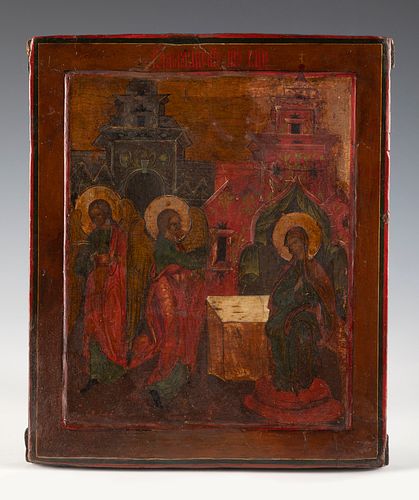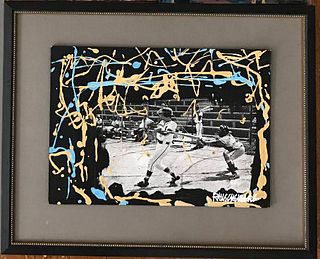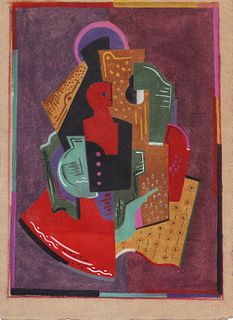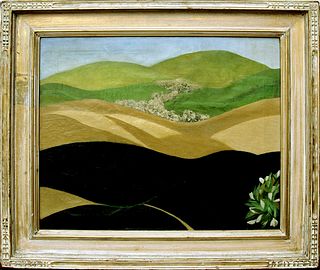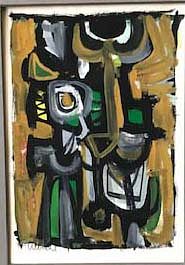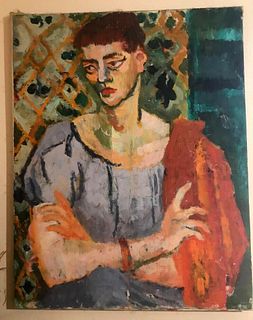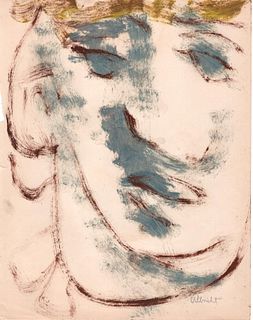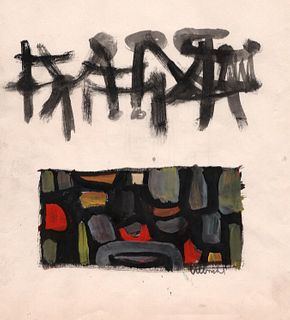Russian school, late 18th century. "Annunciation". Tempera, gold leaf on board.
Lot 94
About Seller
Setdart Auction House
Carrer Aragó 346
Barcelona
Spain
Setdart Subastas was born in 2004 and is currently the first online art auction in Spain with solidity, prestige and reliability guaranteed by our more than 60,000 users. Setdart has a young, dynamic and enterprising team ready to successfully manage the purchase and sale of art works through custom...Read more
Estimate:
EUR€1,000 - EUR€1,200
$1,075.27 - $1,290.32
Absentee vs Live bid
Two ways to bid:
- Leave a max absentee bid and the platform will bid on your behalf up to your maximum bid during the live auction.
- Bid live during the auction and your bids will be submitted real-time to the auctioneer.
Bid Increments
| Price | Bid Increment |
|---|---|
| EUR€0 | EUR€10 |
| EUR€200 | EUR€25 |
| EUR€500 | EUR€50 |
| EUR€1,000 | EUR€100 |
| EUR€3,000 | EUR€200 |
| EUR€5,000 | EUR€500 |
| EUR€10,000 | EUR€1,000 |
| EUR€20,000 | EUR€2,000 |
| EUR€50,000 | EUR€5,000 |
About Auction
By Setdart Auction House
Nov 3, 2021
Set Reminder
2021-11-03 08:00:00
2021-11-03 08:00:00
America/New_York
Bidsquare
Bidsquare : OLD MASTERS
https://www.bidsquare.com/auctions/setdart-auction-house/old-masters-7786
Setdart Auction House sofia@setdart.com
Setdart Auction House sofia@setdart.com
- Lot Description
Russian school, late 18th century. "Annunciation". Tempera, gold leaf on board. Measurements: 32 x 16,5 cm. The icon of interest represents the scene of the Annunciation, with the Virgin seated on the throne on the left, and with double representation of the Archangel Gabriel, on the right. The painter resorts to this unusual technique to transmit the sensation of movement, and to give dynamism and continuity to the scene. Architectural motifs can be found in the background, signifying that the scene takes place inside the church itself. It is a characteristic feature of orthodox iconography to represent interior scenes on the exterior of the building. The painters resorted to this metaphysical trick, not in search of visual verisimilitude, but to be able to tell the maximum information to the believers about the scene through the two-dimensional medium. The chromatic range of the icon, the typology of the faces, and the architecture, as well as the study of the materials, especially wood, help to place it chronologically towards the end of the 18th century. Annunciation, described in the Gospel of Luca, represents one of the most beautiful scenes of the New Testament, when the Archangel Gabriel announces to the Virgin Mary that she is going to be the mother of God. In Christian iconography there is a traditional compositional canon, which may experience slight differences, depending on the school, or the time. In orthodox painting there are three variations of the Annunciation: in the well, with a spindle and in the church. The most recurrent model is the last one, called "in the church", to which the auctioned icon belongs. This prototype develops in Russia towards the beginning of the 16th century. The Virgin seated on the throne, the variation is accepted standing, head bowed, with an affectionate gaze, and she is approached by Archangel Gabriel with the good news. His right hand is raised in a gesture of blessing. Architectural elements usually appear in the background. In the Orthodox tradition, the representation of the Annunciation is adopted from the Byzantine world, and is known from very early times. The first representations of this scene decorated the first Orthodox cathedrals of Ancient Rus. Among the most famous frescoes is the one in the Cathedral of St. Sophia in Kiev. Later, around the 15th century, this iconography was represented in easel art, medium-sized panel icons.
- Shipping Info
-
In-house shipping available. Please inquire at admin@setdart.com.
-
- Buyer's Premium



 EUR
EUR CAD
CAD AUD
AUD GBP
GBP MXN
MXN HKD
HKD CNY
CNY MYR
MYR SEK
SEK SGD
SGD CHF
CHF THB
THB